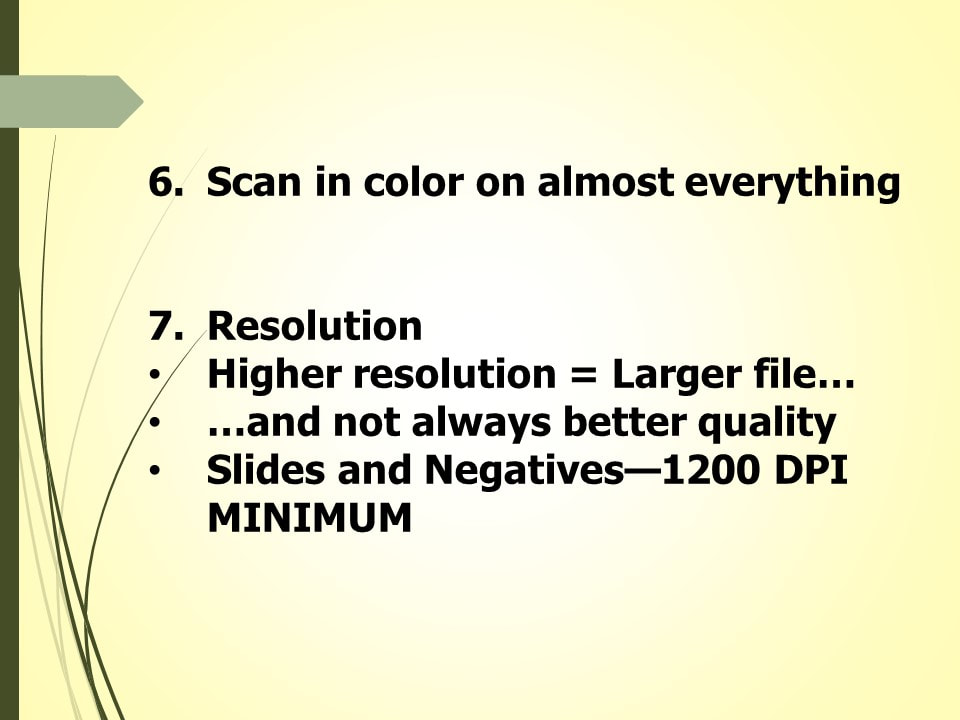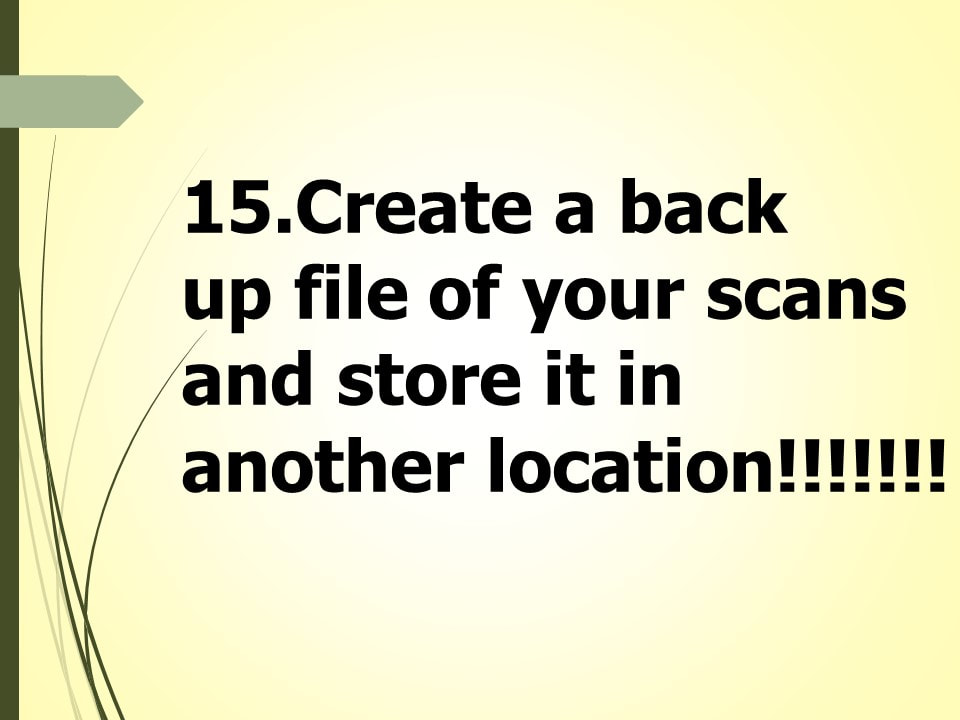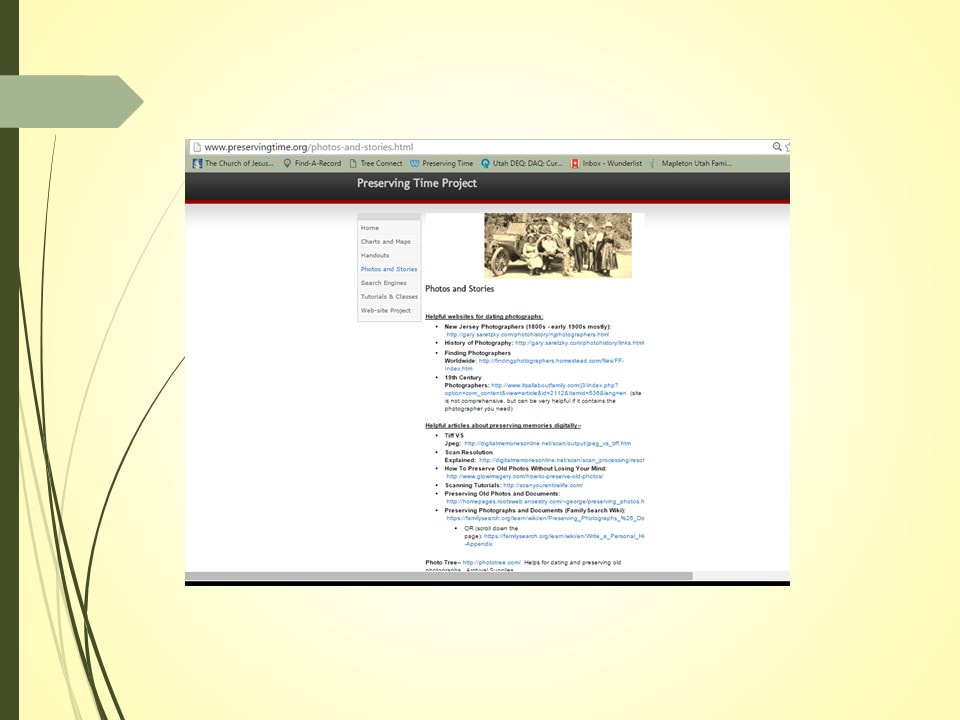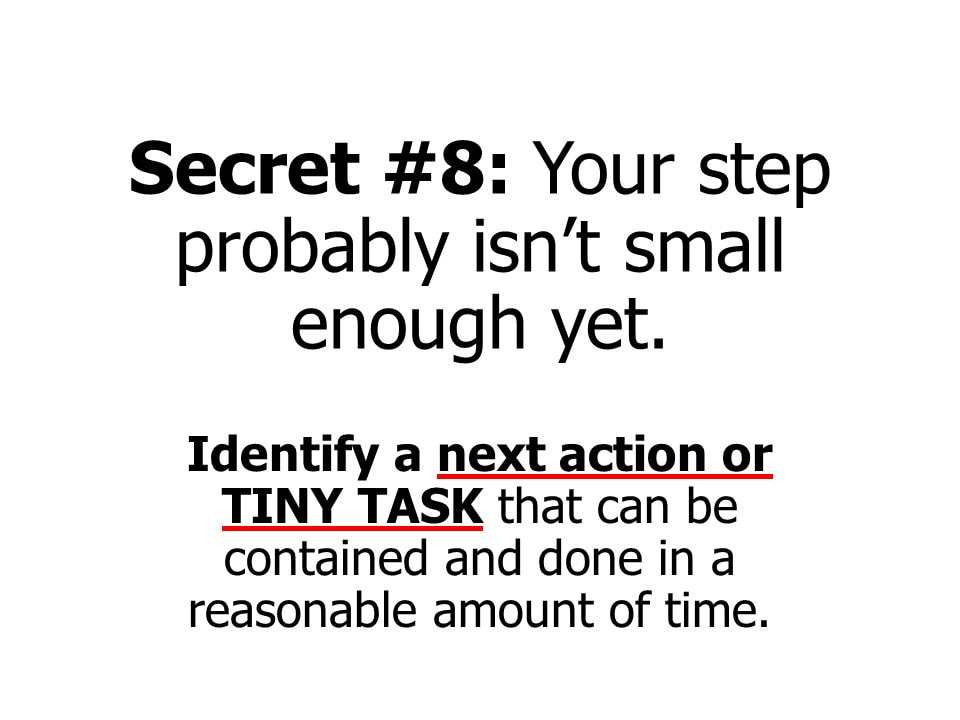| goingdigitalhandout.pdf |
| goingdigitalgenealogy-slides.pdf |
WARNING: Don’t PRINT this handout—you are…
Going Digital with Your Genealogy
Imagine having your family history information available wherever you are. This is the advantage of going digital with your genealogy. This class will focus on starting where you are right now and moving into digitally storing files and recording information in a manageable way. Take time to think about what you are doing and where you want to go. You may want to read this article about systems: https://jamesclear.com/goals-systems
THE SECRET IS IN THE SYSTEM
S—Start where you are now
E—Equipment needed
C—Commit to not generating new papers unnecessarily
R—Realize there will still be some paper involved
E—Evaluate your current system
T—Technology as a Tool not a Toy
IS IN THE
S—Set up destination programs and folders
Y—Your brain
S—Start and Stick to your System
T—Tweak the system
E—Efficient AND Effective.
M—Maintain and backup
S—Start where you are now
Classes I have been to have focused on the months and hard labor it took to go digital. This is not necessary. Work your way through these steps and let the paper get taken care of in the natural course of things. Don’t wait for the perfect system or time…dive in and get started. A family history preserved is infinitely better than the perfect history never started.
E—Equipment needed
C—Commit to not generating new papers unnecessarily
Decide at this point if you want to also maintain a hard copy paper filing system for all of your work. Do you want a hybrid system? Realize that paper is still more archival than computer storage due to technology failure and human error. It probably isn’t necessary to maintain personal copies of census and other records that can easily be retrieved online. Don’t click print automatically. Only print what is essential. Create new documents and notes digitally…and don’t print them. Digitize older items as you have time or as you access them.
Digital Dumping is becoming epidemic. Since storage space has become relatively inexpensive we tend to dump everything into our computers with the intention of sorting it out later. Ask yourself this question: If I were maintaining a paper filing system, would I take time to file this information? Is it information that will still be easily available in the future? If it’s worth saving, it’s worth saving in the correct location in your system.
R—Realize there will still be some paper involved
Paperless is not a reality. There is still a need to archivally preserve original documents and photos. Using paper for some things is the simpler solution. Saving time is more important than being able to say you have “gone paperless”.
E—Evaluate your current system
What is working for you now? What isn’t working? Can your systems that are working continue to work the same way—except exist in a digital format? How many originals do you still need to preserve and store? Do you use a genealogy management program (RootsMagic, Ancestral Quest etc.)?
T—Technology as a Tool not a Toy
If you are constantly trying to find the latest and greatest technology or the perfect program, you won’t be actually accomplishing family history work. Work only with technology that you are comfortable with. If you decide to use a different device or program, learn how to use it before actually using it for family history.
S—Set up destination programs and folders
Combine this step with the “Y” step below. The success of your digital system depends on being consistent in how you save and record information. Establish a consistent file naming procedure. If you don’t have a folder system that functions for you, establish destination folders before you save your next document. Duplicate your paper filing system in a digital format if it is working well for you. Rename old files and folders according to your new system as you access them. Do not rely on Folder Names as part of your File Naming System. You may move files between folders as your work expands. The following have concise information on file naming:
http://oregonstate.edu/cws/training/faq/what-are-good-file-naming-conventions
http://archives.msu.edu/documents/NamingElectronicFiles_v01.pdf
It is also important to take notes in a consistent way. Make sure you save information and citations not just web-links. In your notes record websites that were a waste of time or ones to check back on later. Keep a digital notes page of your most used web links. Screen clippers are important tools when accessing records online. If you have old web links that aren’t working, go to www.archive.org and try the link in the Wayback Machine (archive of cached pages on the internet; make sure you save the information this time-time is your enemy here).
Y—Your Brain
You need to work with your natural tendencies and the way your brain is wired. Don’t try to copy someone else’s system, unless it is a fit for you. There isn’t one right way to organize your family history. Ask yourself though: could someone else step in and follow my system? It is probably a good idea to have a document saved that explains your system. Creating “cheat sheets” for yourself is a good way to stay consistent at what you do.
KEEP YOUR SYSTEM AS SIMPLE AS POSSIBLE! Use chronology, alphabetical, branch of the family, surnames, location or type of record to organize your files rather than a complicated numbering system. If you use a management program and base your filing system on RIN or MRIN numbers, make sure the database is available and the system is explained for those that follow in your footsteps. Color coding is a possibility, but in my experience it seems to cause more work rather than simplifying things.
S—Start and Stick to your System
It takes a certain level of discipline and commitment at this point. Stick to it until it comes naturally as a habit or until you realize what isn’t working correctly for you. Having some sort of system, even if you change it, is better than no system at all.
One important thing to set up is a Quick Start Log. A Quick Start Log is a simple reminder of where you left off and where to pick up the next time you work on family history. I use Todoist for my to-do notes to myself. In a digital Quick Start Log, add your entries to the top of the list rather than the bottom. A paper start log may be a simpler solution for some people, but there is always the risk of it being lost. A sticky note on your computer desktop is another way to handle this log. It needs to be something that is quick click to get into so you can spend time working and not maintaining your organizing system. This is not the same as a research log.
T—Tweak the system
Once you realize what is working for you and what isn’t, tweak your system to fit your needs. This process may have to be repeated a number of times to get to the best system for your personal needs.
E—Efficient AND Effective
Evaluate what you have done in terms of efficiency and effectiveness. These two things often go hand in hand. Sometimes we lose sight of our goals and work our system rather than accomplish the things that are most important.
M—Maintain and backup
I made contact with a cousin through FamilySearch. When she came to Utah for a visit, we got together. I scanned information she had directly to my desktop without entering file names or any organization…capturing as much as possible in the time available was the goal. After the fact, I went back, renamed the files and moved them to the proper location. When files or notes don’t end up in the proper location, take time to move them and keep your system functioning.
THE MOST IMPORTANT PART OF MAINTAINING A DIGITAL SYSTEM IS BACKING UP YOUR DATA. Make sure you have multiple copies of your data stored on current technology and in different physical locations. If you have older media storage such as floppy disks, cassette tapes or CDs, convert the files and/or move them to current technology. Upload information to FamilySearch and share your family history work with your family as an additional backup. Helpful info: http://www.preservingtime.org/avoiding-digital-disasters.html
A Few Specific Keys:
Todoist-- https://todoist.com/
ToDoist is my digital brain. It works for me like no other to-do list or note taking program has. It is very flexible. I gave up my Franklin Planner after many years because ToDoist works so well for me. ToDoist is available for all of the major platforms.
GOOD LUCK!
If you have questions you can contact me at:
[email protected]
More handouts and links to the most helpful websites: www.preservingtime.org/
Going Digital with Your Genealogy
Imagine having your family history information available wherever you are. This is the advantage of going digital with your genealogy. This class will focus on starting where you are right now and moving into digitally storing files and recording information in a manageable way. Take time to think about what you are doing and where you want to go. You may want to read this article about systems: https://jamesclear.com/goals-systems
THE SECRET IS IN THE SYSTEM
S—Start where you are now
E—Equipment needed
C—Commit to not generating new papers unnecessarily
R—Realize there will still be some paper involved
E—Evaluate your current system
T—Technology as a Tool not a Toy
IS IN THE
S—Set up destination programs and folders
Y—Your brain
S—Start and Stick to your System
T—Tweak the system
E—Efficient AND Effective.
M—Maintain and backup
S—Start where you are now
Classes I have been to have focused on the months and hard labor it took to go digital. This is not necessary. Work your way through these steps and let the paper get taken care of in the natural course of things. Don’t wait for the perfect system or time…dive in and get started. A family history preserved is infinitely better than the perfect history never started.
E—Equipment needed
- Scanner(s): It is essential to have access to a scanner of some kind. The Mapleton Family History Center has both photo and sheet fed scanners available.
- Note taking program: Examples of note taking apps and programs: Google Keep or Docs, Microsoft OneNote, Evernote, Word or Open Office document, and MANY more. I also find Todoist to be an invaluable tool.
- Accessible Storage: Unless you only use one device, you will need a way to access your files in different locations. Cloud Storage such as Dropbox or Google, personal web access such as a blog or web site or a USB flash drive or portable hard drive are all options.
- Optional but helpful: Digital Camera or smart phone, Scanner App for smart phone
C—Commit to not generating new papers unnecessarily
Decide at this point if you want to also maintain a hard copy paper filing system for all of your work. Do you want a hybrid system? Realize that paper is still more archival than computer storage due to technology failure and human error. It probably isn’t necessary to maintain personal copies of census and other records that can easily be retrieved online. Don’t click print automatically. Only print what is essential. Create new documents and notes digitally…and don’t print them. Digitize older items as you have time or as you access them.
Digital Dumping is becoming epidemic. Since storage space has become relatively inexpensive we tend to dump everything into our computers with the intention of sorting it out later. Ask yourself this question: If I were maintaining a paper filing system, would I take time to file this information? Is it information that will still be easily available in the future? If it’s worth saving, it’s worth saving in the correct location in your system.
R—Realize there will still be some paper involved
Paperless is not a reality. There is still a need to archivally preserve original documents and photos. Using paper for some things is the simpler solution. Saving time is more important than being able to say you have “gone paperless”.
E—Evaluate your current system
What is working for you now? What isn’t working? Can your systems that are working continue to work the same way—except exist in a digital format? How many originals do you still need to preserve and store? Do you use a genealogy management program (RootsMagic, Ancestral Quest etc.)?
T—Technology as a Tool not a Toy
If you are constantly trying to find the latest and greatest technology or the perfect program, you won’t be actually accomplishing family history work. Work only with technology that you are comfortable with. If you decide to use a different device or program, learn how to use it before actually using it for family history.
S—Set up destination programs and folders
Combine this step with the “Y” step below. The success of your digital system depends on being consistent in how you save and record information. Establish a consistent file naming procedure. If you don’t have a folder system that functions for you, establish destination folders before you save your next document. Duplicate your paper filing system in a digital format if it is working well for you. Rename old files and folders according to your new system as you access them. Do not rely on Folder Names as part of your File Naming System. You may move files between folders as your work expands. The following have concise information on file naming:
http://oregonstate.edu/cws/training/faq/what-are-good-file-naming-conventions
http://archives.msu.edu/documents/NamingElectronicFiles_v01.pdf
It is also important to take notes in a consistent way. Make sure you save information and citations not just web-links. In your notes record websites that were a waste of time or ones to check back on later. Keep a digital notes page of your most used web links. Screen clippers are important tools when accessing records online. If you have old web links that aren’t working, go to www.archive.org and try the link in the Wayback Machine (archive of cached pages on the internet; make sure you save the information this time-time is your enemy here).
Y—Your Brain
You need to work with your natural tendencies and the way your brain is wired. Don’t try to copy someone else’s system, unless it is a fit for you. There isn’t one right way to organize your family history. Ask yourself though: could someone else step in and follow my system? It is probably a good idea to have a document saved that explains your system. Creating “cheat sheets” for yourself is a good way to stay consistent at what you do.
KEEP YOUR SYSTEM AS SIMPLE AS POSSIBLE! Use chronology, alphabetical, branch of the family, surnames, location or type of record to organize your files rather than a complicated numbering system. If you use a management program and base your filing system on RIN or MRIN numbers, make sure the database is available and the system is explained for those that follow in your footsteps. Color coding is a possibility, but in my experience it seems to cause more work rather than simplifying things.
S—Start and Stick to your System
It takes a certain level of discipline and commitment at this point. Stick to it until it comes naturally as a habit or until you realize what isn’t working correctly for you. Having some sort of system, even if you change it, is better than no system at all.
One important thing to set up is a Quick Start Log. A Quick Start Log is a simple reminder of where you left off and where to pick up the next time you work on family history. I use Todoist for my to-do notes to myself. In a digital Quick Start Log, add your entries to the top of the list rather than the bottom. A paper start log may be a simpler solution for some people, but there is always the risk of it being lost. A sticky note on your computer desktop is another way to handle this log. It needs to be something that is quick click to get into so you can spend time working and not maintaining your organizing system. This is not the same as a research log.
T—Tweak the system
Once you realize what is working for you and what isn’t, tweak your system to fit your needs. This process may have to be repeated a number of times to get to the best system for your personal needs.
E—Efficient AND Effective
Evaluate what you have done in terms of efficiency and effectiveness. These two things often go hand in hand. Sometimes we lose sight of our goals and work our system rather than accomplish the things that are most important.
M—Maintain and backup
I made contact with a cousin through FamilySearch. When she came to Utah for a visit, we got together. I scanned information she had directly to my desktop without entering file names or any organization…capturing as much as possible in the time available was the goal. After the fact, I went back, renamed the files and moved them to the proper location. When files or notes don’t end up in the proper location, take time to move them and keep your system functioning.
THE MOST IMPORTANT PART OF MAINTAINING A DIGITAL SYSTEM IS BACKING UP YOUR DATA. Make sure you have multiple copies of your data stored on current technology and in different physical locations. If you have older media storage such as floppy disks, cassette tapes or CDs, convert the files and/or move them to current technology. Upload information to FamilySearch and share your family history work with your family as an additional backup. Helpful info: http://www.preservingtime.org/avoiding-digital-disasters.html
A Few Specific Keys:
- If you are using programs such as Word, Excel or OneNote the software must be available on all devices you will be working with. Products that are cross platform and use more standard formats (.rtf, .txt or .odt), may be a better choice. Search for: Apache OpenOffice, LibreOffice and NeoOffice. Downloads of these programs are free.
- When working with digital photo files, it is safest to have a folder of original copies of the files that is never touched. Most problems with photos happen when the files are opened, edited and then saved. Do all adjustments on a copy of the original photo file. TIFF is generally the choice for archiving. JPEG is a lossy file format, but is more popular because of its smaller file size. If you must archive in JPEG, do it at very little or no compression and don’t work on the original file. Always make a copy to avoid data loss. Think of the loss of detail when making a copy of a copy of a copy of an original on a copy machine. There are mixed recommendations on using editing capabilities of a scanner.
- When establishing your file destinations, use the same guidelines that have worked for you in your paper filing systems. Separate files into working files and archive files; Separate reference materials into general reference and location specific references. Decide if you want source images integrated with your notes or filed independently. There are advantages and disadvantages of both systems. You can create links between files and notes, but these links will not work if the item is moved around.
- Be consistent in gathering information on women and non-direct ancestor families. Are they filed with their father or husband? …or on their own? What about non-direct ancestor children?
Todoist-- https://todoist.com/
ToDoist is my digital brain. It works for me like no other to-do list or note taking program has. It is very flexible. I gave up my Franklin Planner after many years because ToDoist works so well for me. ToDoist is available for all of the major platforms.
GOOD LUCK!
If you have questions you can contact me at:
[email protected]
More handouts and links to the most helpful websites: www.preservingtime.org/



